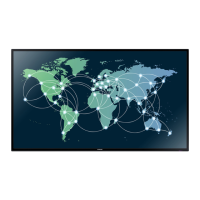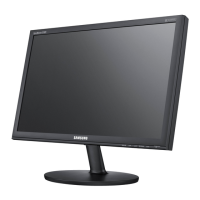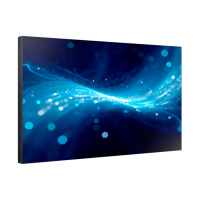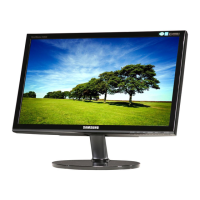Do you have a question about the Samsung ED32D and is the answer not in the manual?
Details copyright information for the manual.
Provides crucial safety warnings and cautions for product use.
Instructions on how to clean the product safely.
Guidelines for storing the product properly.
Essential safety information regarding electricity and product usage.
Warnings and instructions for safe product installation.
Important safety guidelines and warnings for operating the product.
Instructions to verify all product components are present.
Identifies and describes the various ports on the product's reverse side.
Information on how to secure the product using an anti-theft lock.
Details the functions of the remote control buttons.
Guidance for product installation, including tilt and ventilation.
Provides detailed product dimensions for installation planning.
Instructions and recommendations for mounting the product on a wall.
Details VESA mounting standards and screw specifications.
Technical specifications for RS232C serial communication.
General advice before connecting external devices.
Instructions for connecting a PC to the display.
Diagram for connecting a PC via a D-SUB analog cable.
Diagram for connecting a PC via a DVI digital cable.
Diagram for connecting a PC via an HDMI-DVI cable.
Recommendations for using HDMI cables for optimal quality.
General instructions for connecting video devices.
Diagram for connecting to an audio system.
How to select and change the active input source.
Steps to assign IDs for Multi Control setup.
Detailed steps for installing and uninstalling the MDC program.
Explanation of Multiple Display Control (MDC) software.
Selection of display modes based on input source for optimal viewing.
Adjusts core picture quality parameters for optimal display.
Options for adjusting aspect ratio and magnification of the displayed image.
Adjusts the picture's on-screen position.
Allows for image zooming and repositioning.
Selects screen resolution for optimal display.
Automatically fine-tunes display settings for clarity.
Fine-tunes PC display settings like noise reduction and position.
Configures Picture-in-Picture display settings.
Accesses advanced picture settings like Dynamic Contrast and Black Tone.
Provides options for Color Tone, Digital Clean View, and noise filters.
Turns off the screen while keeping audio active.
Resets all picture settings to default values.
Selects sound profiles (Standard, Music, Movie, Clear Voice, Amplify).
Configures sound effects like DTS TruSurround and Equalizer.
Selects audio output source (Internal, External, Receiver).
Resets all sound settings to factory defaults.
Manages and displays connected input sources.
Refreshes the list of available input devices.
Renames source devices for better identification.
Displays detailed information about connected external devices.
Sets the display language for the on-screen menu.
Configures settings for controlling multiple displays.
Sets the clock and timer functions for the product.
Manages power saving features like Energy Saving and Eco Sensor.
Features to prevent screen burn-in, including Pixel Shift.
Configures text ticker display settings.
Controls and configures multi-display Video Wall setups.
Configures automatic switching between video input sources.
Sets a new PIN for security.
Resets system settings to factory defaults.
Exports or loads product settings via USB.
Resets all display settings to factory defaults.
Instructions for upgrading product software.
How to contact support for product information and upgrades.
Steps to take before contacting customer service.
Procedure to test product functionality before seeking support.
Guidance on checking display resolution and frequency settings.
Checks for installation and screen issues.
Troubleshooting steps for various screen display problems.
Troubleshooting steps for audio problems.
Solutions for when the remote control is not working.
Addresses miscellaneous issues like caption, PIP, and HDMI sound.
Answers frequently asked questions about frequency and resolution.
Provides general specifications including model, size, and dimensions.
Details power consumption modes and specifications.
Lists supported resolutions and timing modes for optimal picture quality.
Contact information for Samsung customer support globally.
Details when service fees may apply, including non-defect issues.
Tips for maintaining picture quality and preventing screen burn-in.
Information on Dolby, DTS, and DivX licenses and open source notices.
Definitions of technical terms related to display technology.
Details copyright information for the manual.
Provides crucial safety warnings and cautions for product use.
Instructions on how to clean the product safely.
Guidelines for storing the product properly.
Essential safety information regarding electricity and product usage.
Warnings and instructions for safe product installation.
Important safety guidelines and warnings for operating the product.
Instructions to verify all product components are present.
Identifies and describes the various ports on the product's reverse side.
Information on how to secure the product using an anti-theft lock.
Details the functions of the remote control buttons.
Guidance for product installation, including tilt and ventilation.
Provides detailed product dimensions for installation planning.
Instructions and recommendations for mounting the product on a wall.
Details VESA mounting standards and screw specifications.
Technical specifications for RS232C serial communication.
General advice before connecting external devices.
Instructions for connecting a PC to the display.
Diagram for connecting a PC via a D-SUB analog cable.
Diagram for connecting a PC via a DVI digital cable.
Diagram for connecting a PC via an HDMI-DVI cable.
Recommendations for using HDMI cables for optimal quality.
General instructions for connecting video devices.
Diagram for connecting to an audio system.
How to select and change the active input source.
Steps to assign IDs for Multi Control setup.
Detailed steps for installing and uninstalling the MDC program.
Explanation of Multiple Display Control (MDC) software.
Selection of display modes based on input source for optimal viewing.
Adjusts core picture quality parameters for optimal display.
Options for adjusting aspect ratio and magnification of the displayed image.
Adjusts the picture's on-screen position.
Allows for image zooming and repositioning.
Selects screen resolution for optimal display.
Automatically fine-tunes display settings for clarity.
Fine-tunes PC display settings like noise reduction and position.
Configures Picture-in-Picture display settings.
Accesses advanced picture settings like Dynamic Contrast and Black Tone.
Provides options for Color Tone, Digital Clean View, and noise filters.
Turns off the screen while keeping audio active.
Resets all picture settings to default values.
Selects sound profiles (Standard, Music, Movie, Clear Voice, Amplify).
Configures sound effects like DTS TruSurround and Equalizer.
Selects audio output source (Internal, External, Receiver).
Resets all sound settings to factory defaults.
Manages and displays connected input sources.
Refreshes the list of available input devices.
Renames source devices for better identification.
Displays detailed information about connected external devices.
Sets the display language for the on-screen menu.
Configures settings for controlling multiple displays.
Sets the clock and timer functions for the product.
Manages power saving features like Energy Saving and Eco Sensor.
Features to prevent screen burn-in, including Pixel Shift.
Configures text ticker display settings.
Controls and configures multi-display Video Wall setups.
Configures automatic switching between video input sources.
Sets a new PIN for security.
Resets system settings to factory defaults.
Exports or loads product settings via USB.
Resets all display settings to factory defaults.
Instructions for upgrading product software.
How to contact support for product information and upgrades.
Steps to take before contacting customer service.
Procedure to test product functionality before seeking support.
Guidance on checking display resolution and frequency settings.
Checks for installation and screen issues.
Troubleshooting steps for various screen display problems.
Troubleshooting steps for audio problems.
Solutions for when the remote control is not working.
Addresses miscellaneous issues like caption, PIP, and HDMI sound.
Answers frequently asked questions about frequency and resolution.
Provides general specifications including model, size, and dimensions.
Details power consumption modes and specifications.
Lists supported resolutions and timing modes for optimal picture quality.
Contact information for Samsung customer support globally.
Details when service fees may apply, including non-defect issues.
Tips for maintaining picture quality and preventing screen burn-in.
Information on Dolby, DTS, and DivX licenses and open source notices.
Definitions of technical terms related to display technology.
| HD type | WXGA |
|---|---|
| Panel life | - h |
| Color gamut | 70 % |
| Pixel pitch | 0.17025 x 0.51075 mm |
| Touchscreen | - |
| Response time | 8 ms |
| Display diagonal | 32 \ |
| Display brightness | 330 cd/m² |
| Display resolution | 1366 x 768 pixels |
| Display technology | LED |
| Contrast ratio (typical) | 4000:1 |
| Display number of colors | 16.78 million colors |
| Display diagonal (metric) | 81.28 cm |
| Active display area (W x H) | 697.6845 x 392.256 mm |
| Ethernet LAN | No |
| Product color | Black |
| Product design | Digital signage flat panel |
| Panel mounting interface | 200 x 200 mm |
| AC input voltage | 100 - 240 V |
| AC input frequency | 50 - 60 Hz |
| Power consumption (off) | 0.5 W |
| Power consumption (standby) | - W |
| Power consumption (typical) | 47 W |
| Cables included | VGA |
| Package depth | 162 mm |
| Package width | 826 mm |
| Package height | 530 mm |
| Package weight | 7600 g |
| Depth | 93.7 mm |
|---|---|
| Width | 736 mm |
| Height | 434.5 mm |
| Weight | 6000 g |











